Extracellular vesicles (EVs) are otherwise known as exosomes.
These are similar to tiny packages that cells send out to communicate with each other. They help keep our body working properly and can also play a role in diseases. One type of these vesicles is called exosomes, which are really small – about 100 times thinner than a human hair!
Exosomes are made inside cells, and they carry a mix of different things like DNA, proteins, fats, and other stuff. What they carry can tell us a lot about the cell they came from. So, if a cell is sick, its exosomes might carry some clues about what’s going wrong.
In fact, scientists can find exosomes in body fluids like blood or urine, and by studying them, they might be able to figure out if a person has a disease. This could be a new way to diagnose illnesses!
Also, because exosomes are so good at delivering stuff between cells, scientists are thinking about how to use them like tiny delivery trucks to send medicines right where they’re needed in the body.
BACKGROUND ON EXOSOMES
Ok, let’s break it down:
All types of cells, whether they’re simple cells like bacteria or complex cells like those in humans, send out tiny bubble-like structures called extracellular vesicles (EVs). This happens normally, but also when something goes wrong with the cell.
There are two main types of these vesicles: ectosomes and exosomes. Ectosomes are like little bubbles that pop off from the cell’s outer layer. They can be different sizes but are generally between 50 and 1000 times smaller than the width of a human hair.
“…Stem cells are about 100 μm, which is 1000 times larger than exosomes.”
By the way, stem cells are about 100 μm, which is 1000 times larger than exosomes.
have a radius.In other words, the culture supernatant contains many MVs other than exosomes, and has a composition different from that of pure exosomes.
Exosomes are even smaller, usually around 100 times smaller than the width of a human hair, and they’re made inside the cell. The cell’s outer layer folds in on itself to form a sort of pocket, which can then fill up with different things from inside the cell. This pocket can also mix with other pockets inside the cell, which makes each exosome unique.
These vesicles, including exosomes, can carry all sorts of things that are normally found inside a cell, like DNA, fats, proteins, and other molecules. We’re not entirely sure why cells make exosomes, but one idea is that they help get rid of stuff the cell doesn’t need anymore.
But that’s not all – recent research suggests that exosomes might also be a way for cells to talk to each other. They could be sending specific messages or materials to other cells, which could help the cells work together better.
ADVANCES WITH EXOSOMES
\Alright, let’s make this exosome thing even easier to understand…
Exosomes are like tiny packages that cells send out to each other. They’re involved in a lot of different things in the body, like how our immune system works, how viruses cause disease, pregnancy, heart diseases, brain diseases, and even how cancer grows.
These tiny packages can carry proteins, small molecules, and genetic material to other cells and change how those cells behave. Sometimes, this can make a disease worse, but other times it can help control the disease.
Because exosomes can influence so many different things in the body, scientists are looking at how we can use them to treat diseases, like brain disorders and cancer. We can actually load these exosomes with different types of medicines and program them to deliver these medicines to specific targets in the body.
The makeup of exosomes can affect how they move around in the body, and their natural components might help improve how well the medicine works and reduce side effects.
But that’s not all – exosomes could also help us diagnose diseases.
They’re found in all body fluids, and by looking at what’s inside these exosomes, we might be able to tell if a person has a disease like cancer. This could be done by taking a sample of body fluid, a process known as a liquid biopsy. By studying exosomes, we could also track how a disease is progressing and how well a treatment is working.
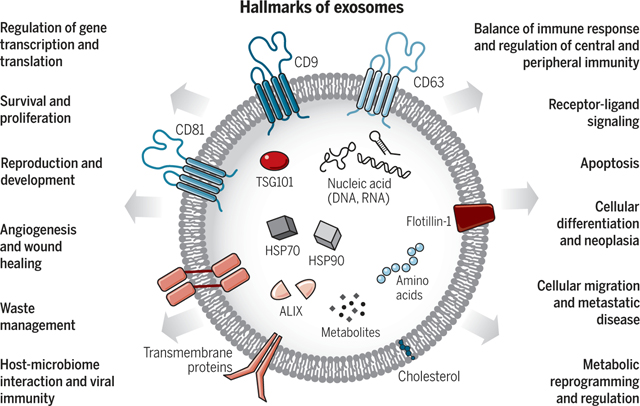
Exosomes are extracellular vesicles generated by all cells and they carry nucleic acids, proteins, lipids, and metabolites. They are mediators of near and long-distance intercellular communication in health and disease and affect various aspects of cell biology.
Kalluri R, LeBleu VS. The biology, function, and biomedical applications of exosomes. Science. 2020;367(6478):eaau6977. doi:10.1126/science.aau6977
WHAT IS THE OUTLOOK ON EXOSOMES?
The outlook is amazing to put it simply.
Scientists are really interested in studying exosomes, those tiny packages that cells send out. They’re making a lot of progress and are hoping to learn more about how different each exosome can be and what they do in the body. This could help us use exosomes to treat diseases or diagnose them.
Right now, researchers are working on better ways to study exosomes, and this will probably show us that not all exosomes are the same. But even with what we know now, we’ve learned a lot about how exosomes can contribute to different diseases.
Scientists are also developing new ways to study exosomes in mice. This could help us understand how exosomes help cells talk to each other, both close by and in different parts of the body.
We’re not sure yet if the way cells make exosomes and what they put in them changes as we get older. If it does, this could tell us more about how our bodies age.
There’s also a cool idea that exosomes might have been around even before the first single-celled organisms. Future experiments might be able to tell us more about this.
New techniques that let us look at individual exosomes in really high detail could greatly improve our understanding of exosomes. This could help us figure out how to use exosomes to treat a variety of diseases, including cancer and diseases that affect the brain.
Let’s make this fun and easy to understand:
Imagine cells in our body are like little factories. These factories make tiny bubbles called extracellular vesicles (EVs). Scientists are really interested in these bubbles because they help our body stay healthy and can also tell us a lot about different diseases, like brain diseases, heart problems, and even cancer.
There are two main types of these bubbles: ectosomes and exosomes. Ectosomes are like bubbles that pop off from the factory’s outer wall. They can be different sizes but are usually really tiny. Exosomes are even smaller and are made inside the factory.
Scientists are trying to learn more about these bubbles, like how they’re made and what they do. But studying them is tricky because they’re so small and there are so many of them. It’s like trying to study a single grain of sand on a huge beach!
Even though it’s hard, scientists have already learned a lot. For example, they found out that these bubbles are in all body fluids, like blood or pee. This means that by studying these bubbles, we might be able to tell if someone is sick, kind of like a detective looking for clues.
But there’s still a lot we don’t know. For example, we’re not sure if all exosomes are the same or if different factories make different kinds of exosomes. As we get better tools and techniques, we’ll be able to learn even more about these amazing little bubbles!
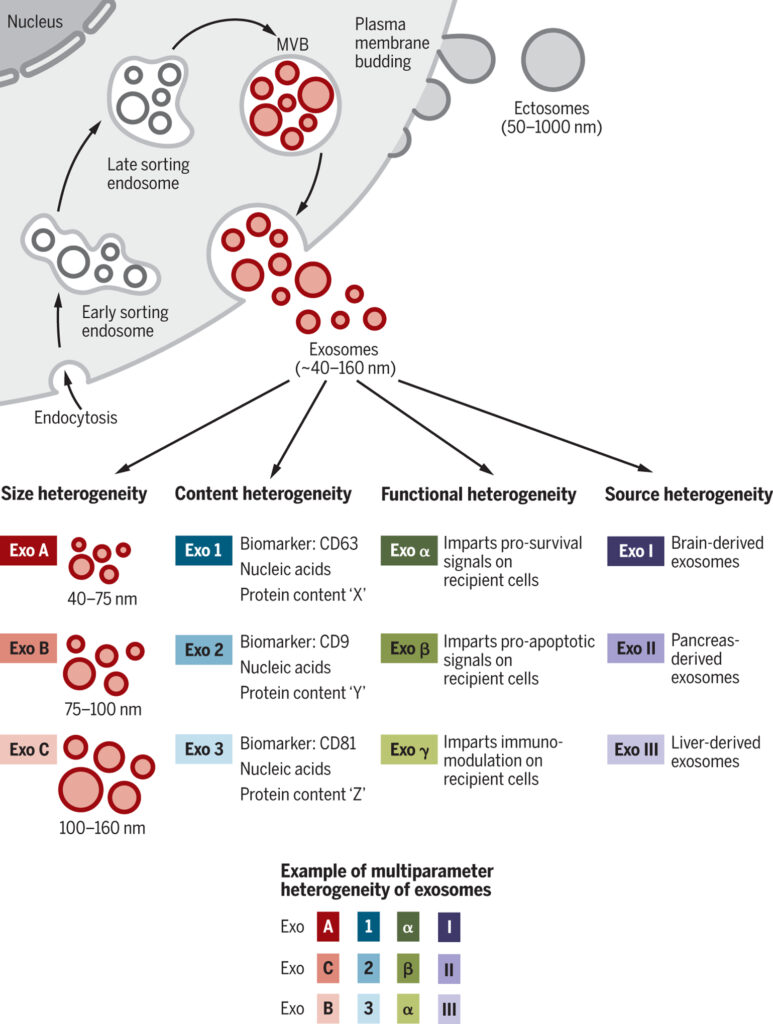
THE BIOGENESIS OF EXOSOMES: A METAPHOR
So let’s use a factory metaphor to explain this complex process:
Imagine a cell as a busy factory. This factory makes tiny bubble-like packages called exosomes. The process of making these exosomes is a bit like making a double-layered bubble inside the factory.
First, the factory wall bends inwards, creating a cup-shaped pocket. This pocket captures some materials from both inside and outside the factory. This pocket then pinches off and becomes a separate compartment inside the factory, like a little room or storage area. This is called an early-sorting endosome (ESE).
This ESE can mature and turn into a late-sorting endosome (LSE), which is like a more advanced storage area. This LSE can then create a special kind of room called a multivesicular body (MVB). This MVB is special because it contains lots of tiny bubbles inside it, which are future exosomes.
Now, this MVB can do two things. It can either merge with the factory’s recycling center (the lysosome) where its contents are broken down, or it can move to the factory wall and merge with it. When it merges with the factory wall, all the tiny bubbles inside it (the exosomes) are released outside the factory.
There are many different machines and workers in the factory that help with this process. Some of them help create the pockets in the factory wall, some help turns these pockets into MVBs, and some help release the exosomes outside the factory. But we’re still trying to understand exactly how all these machines and workers do their jobs.
Also, it’s important to know that different factories might make exosomes at different rates. For example, some studies suggest that factories in unhealthy conditions (like cancer cells) might make fewer exosomes than healthy factories. But this is still a topic of ongoing research.

THE HETEROGENEITY OF EXOSOMES: A SIMPLE TAKE
So let’s, let’s use a metaphor of a post office to explain this one:
Imagine exosomes as letters being sent out by different post offices (cells). These letters (exosomes) can be different in many ways, just like how letters can be of different sizes, contain different messages, and be sent to different places.
- Size: Just like letters can be big or small, exosomes can also be different sizes. This could be because of how they’re made inside the cell, or because of the methods we use to study them.
- Content: The content of the letters (exosomes) can also be different. They can contain different types of materials, like proteins, fats, and genetic material. But not all exosomes contain the same amount of each material. It’s like how some letters might have a long message, while others only have a short note.
- Effect on recipient cells: The effect of exosomes on the cells that receive them can also vary. It’s like how a letter can make you happy, sad, or surprised, depending on its message. Some exosomes might help cells survive, while others might cause cells to die or change how they behave.
- The cell of origin: The cell that makes the exosome can also affect its properties. It’s like how a letter from a friend might be different from a letter from a company. For example, exosomes from cancer cells might have different properties than exosomes from healthy cells.
So, just like a post office sends out many different types of letters, our cells send out many different types of exosomes. This makes the world of exosomes very complex and interesting to study!
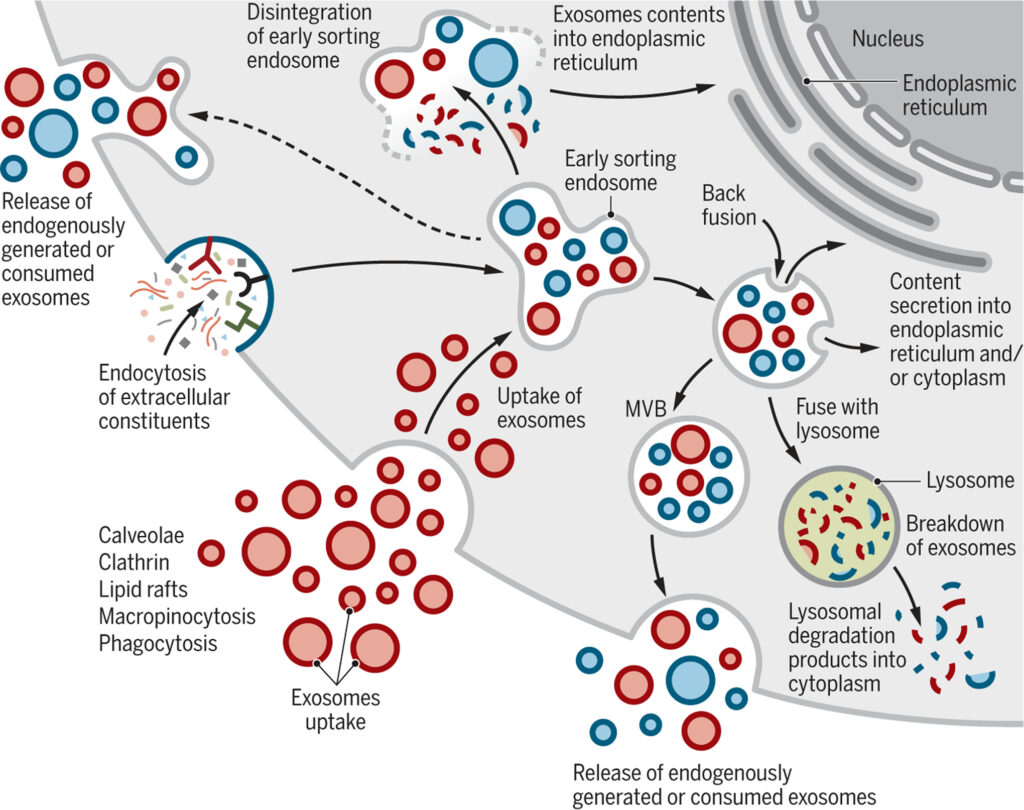
MAMMALIAN REPRODUCTION AND DEVELOPMENT (EXOSOMES)
It’s not that bad, so, let’s break this down:
Exosomes are like tiny packages that cells send out to each other. Scientists are trying to figure out what happens to the stuff inside these packages when they reach the cell they were sent to. They’re also trying to understand how these packages change the behavior of the cell that receives them.
When a cell gets an exosome, it can take it in and then send it back out again. This means that over time, a cell might be sending out a mix of exosomes it made itself and exosomes it received from other cells.
Different cells might take in exosomes in different ways. For example, some cancer cells might swallow up exosomes in a process similar to how a cell eats. Other cells might merge with the exosome to take in its contents. It’s still unclear if the way a cell takes in an exosome affects what happens to the stuff inside the exosome.
Also, when scientists add exosomes from different types of cells into animals, these exosomes might go to different organs or stay in the body for different amounts of time. This is different from what happens when a cell naturally makes exosomes.
Experiments in mice have shown that exosomes can deliver genetic material to a cell, but this seems to happen rarely. This might happen more often when the immune system is activated, like during inflammation.
The stuff inside an exosome can change depending on the cell it came from. For example, exosomes from cancer cells might contain different proteins than exosomes from healthy cells. These proteins can send specific signals to the cell that receives the exosome, which can affect things like growth, immune response, and disease.
Mamillian Reproduction & Exosomes
Sure, let’s make this easy to understand:
When it comes to human reproduction and development, cells need to talk to each other a lot. They do this by sending out tiny packages called exosomes. These exosomes are found in many body fluids, like semen, amniotic fluid (the fluid that surrounds a baby in the womb), blood, and breast milk.
In semen, exosomes might help sperm mature. They contain certain types of genetic material (called microRNAs) that might help control the immune response in the reproductive organs. They might also help protect against HIV, a virus that can cause AIDS.
In pregnancy, exosomes might help protect the baby from infections. For example, exosomes from the placenta (the organ that provides nutrients to the baby in the womb) can help protect against certain viruses. The exosomes in a pregnant woman’s blood also change throughout pregnancy and might be linked to the timing of labor and delivery.
Breast milk also contains exosomes that might help keep a baby healthy after it’s born. These exosomes contain microRNAs that are involved in the immune system and might help control the baby’s immune response. They might also help the cells in the baby’s gut grow. However, we’re not sure how much of the stuff inside these exosomes actually makes it into the baby’s body after the milk is digested.
So, exosomes play a big role in reproduction and development. They’re like tiny messengers that help cells communicate and coordinate their actions.
WHAT ABOUT EXOSOMES AND MAMMALIAN REPRODUCTION?
Yes, that is us as humans, having sex.
When it comes to human reproduction and development, cells need to talk to each other a lot. They do this by sending out tiny packages called exosomes. These exosomes are found in many body fluids, like semen, amniotic fluid (the fluid that surrounds a baby in the womb), blood, and breast milk.
In semen, exosomes might help sperm mature. They contain certain types of genetic material (called microRNAs) that might help control the immune response in the reproductive organs. They might also help protect against HIV, a virus that can cause AIDS.
In pregnancy, exosomes might help protect the baby from infections. For example, exosomes from the placenta (the organ that provides nutrients to the baby in the womb) can help protect against certain viruses. The exosomes in a pregnant woman’s blood also change throughout pregnancy and might be linked to the timing of labor and delivery.
Breast milk also contains exosomes that might help keep a baby healthy after it’s born. These exosomes contain microRNAs that are involved in the immune system and might help control the baby’s immune response. They might also help the cells in the baby’s gut grow. However, we’re not sure how much of the stuff inside these exosomes actually makes it into the baby’s body after the milk is digested.
So, exosomes play a big role in reproduction and development. They’re like tiny messengers that help cells communicate and coordinate their actions.
EXOSOME MODULATION OF IMMUNE RESPONSE & INFECTION
This is where exosomes start to get even more interesting.
Exosomes, those tiny packages sent out by cells, play a big role in our immune system. They can help our body fight off infections and diseases, including cancer. But, they can also be used by diseases to help them spread and avoid our immune system.
For example, exosomes can help our immune system recognize and attack cancer cells. They can carry pieces of cancer cells to our immune cells, which then learn what the cancer cells look like and how to destroy them. But, cancer cells can also release their own exosomes that can trick our immune system and help the cancer spread.
Exosomes can also interact with our immune system in other ways. They can carry genetic material that can turn on or off certain genes in our immune cells. This can either boost our immune response or tone it down.
When it comes to infections, exosomes can both help and hinder them. Some exosomes can carry pieces of bacteria or viruses to our immune cells, helping them recognize and attack the invaders. But, some bacteria and viruses can also use exosomes to spread in our bodies. They can hide inside exosomes to avoid being detected by our immune system, or they can use exosomes to enter our cells more easily.
So, exosomes are like double agents in our bodies. They can work for us, helping our immune system fight off diseases. But they can also work against us, helping diseases spread and avoid our immune defenses. It’s a complex and fascinating system that scientists are still trying to fully understand.
Exosomes and how they act on inflammation (READ MORE).
EXOSOMES: THE HEART, BRAIN & CANCER
Let’s take a moment to look at how exosomes play a role in cardiovascular disease (CVD), neurodegeneration, and cancer. Moreover, what are the implications for exosomes in therapeutic useage.
- Exosomes and Metabolic and Cardiovascular Diseases:
Exosomes are like tiny delivery trucks that cells use to send messages and materials to each other. They can carry things like fats, sugars, and even genetic material. In the context of metabolic and heart diseases, these exosomes can play a big role. For example, in obesity, exosomes can carry a protein called RBP4 that can make cells resistant to insulin, a hormone that helps control blood sugar levels. In heart diseases, exosomes can carry messages that help protect the heart, like reducing the uptake of harmful cholesterol or promoting heart muscle function.
- Exosomes and Neurodegeneration:
Exosomes can also play a role in brain diseases like Alzheimer’s and Parkinson’s. They can help clean up misfolded proteins in the brain, which can be protective. But they can also spread these misfolded proteins, which can make the disease worse. For example, in Alzheimer’s disease, exosomes can carry a protein called Tau, which can cause damage when it clumps together. But they can also help remove harmful proteins from brain cells. So, exosomes can be both helpful and harmful in these diseases.
- Cancer and Exosomes:
In cancer, exosomes can act like double agents. They can help cancer cells grow and spread by carrying messages and materials that promote tumor growth. For example, they can carry genetic material that can transform normal cells into cancer cells. They can also help create a friendly environment for cancer cells to grow in other parts of the body. But on the flip side, exosomes can also carry messages that make cancer cells more resistant to treatments like chemotherapy. So, while they can help cancer grow and spread, they can also make it harder to treat.
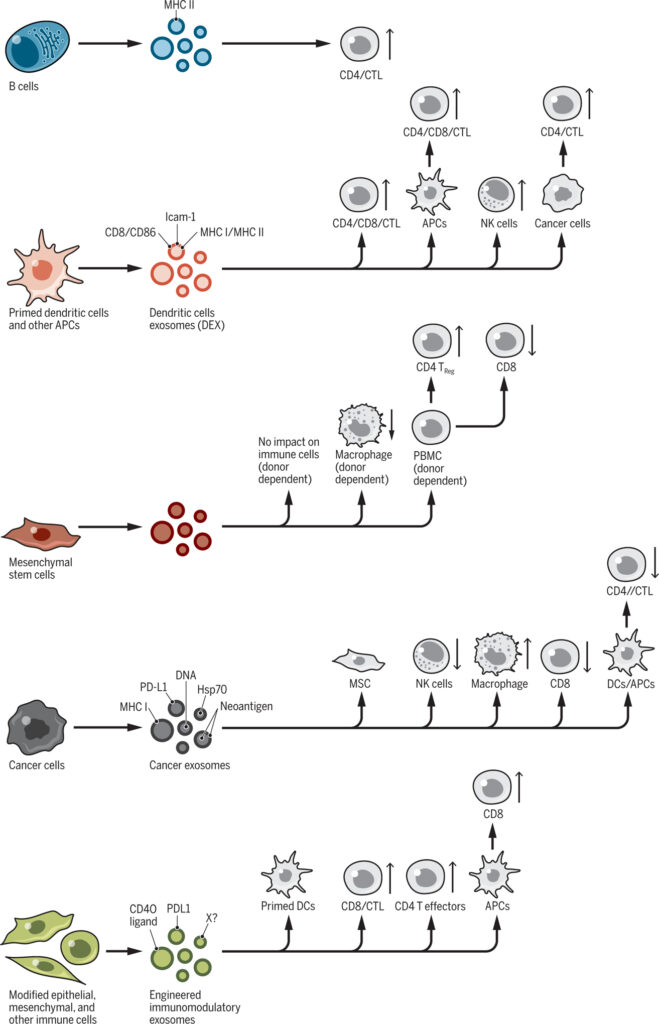
Excitingly, exosomes derived from various cell types, including immune cells and cancer cells, carry substances that can positively influence the activity of other immune cells.
They (exosomes) have the potential to enhance or regulate the growth and function of T cells, which play a crucial role in immune responses.
Regulation of immune response by exosomes.
Further exploration of these immunomodulatory properties of exosomes holds great promise for advancing our understanding and developing new therapeutic strategies in the field of immunology.
All that taken into consideration – here is the practical side of exosomes:
- Clinical Applications of Exosomes:
Exosomes are tiny packages that cells send to each other. They can carry all sorts of things, like proteins, fats, sugars, and even genetic material. This makes them very useful for doctors and scientists. They can use exosomes to learn more about diseases and how they progress. They can also use exosomes as a way to deliver treatments directly to diseased cells.
- Diagnostic Potential of Exosomes:
Exosomes can be found in all body fluids and are produced by all cells. This makes them a great tool for diagnosing diseases. Think of exosomes as tiny messengers that can tell us what’s happening inside the body. For example, in cancer, exosomes can carry genetic material that can help doctors detect the disease early. They can also carry specific proteins that can tell doctors how the disease is progressing. This makes exosomes a powerful tool for diagnosing and monitoring diseases like heart disease, brain disorders, and cancer.
And finally, the….
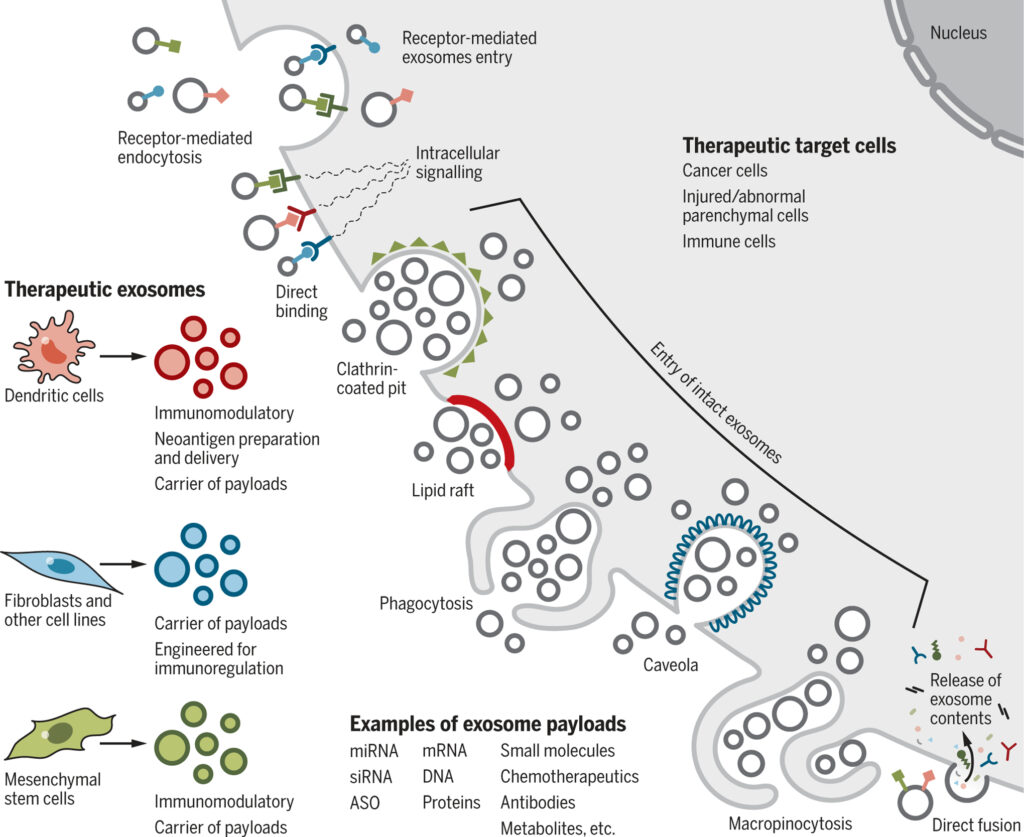
THERAPEUTIC USE OF EXOSOMES
Our favorite part.
Exosomes are like tiny mail trucks that cells use to send stuff to each other. Scientists are finding out that these exosomes can be used to deliver medicine directly to sick cells in our bodies. This is really cool because these tiny mail trucks are very good at getting inside other cells and they don’t seem to bother our immune system either (unless severely immunocompromised).
For example, scientists have been able to put cancer drugs inside exosomes and send them to fight cancer cells in mice. They’ve also been able to put special molecules called RNA inside exosomes to turn off bad genes in cancer cells.
Please note: not all exosomes carry genetic material. Exosomes can be bundled with many things depending on what the scientist is trying to achieve.
Exosomal cargo such as IFNα or APOBEC3G can suppress infection by limiting viral replication or enhancing antiviral immunity.
In addition to cancer, scientists are also exploring how exosomes can be used to treat brain diseases. They’ve found that exosomes can cross the blood-brain barrier, which is a protective wall that keeps most things out of the brain. This is a big deal because many medicines can’t get past this barrier.
Finally, scientists are also looking at how exosomes can help our immune system fight off cancer. They’ve done some early tests in people with lung cancer and found that exosomes can help boost the body’s natural defenses.
In short, these tiny mail trucks called exosomes have the potential to deliver medicines and help treat a variety of diseases.
CONCLUSIONS: EXOSOMES ARE HERE TO STAY
Here are some radio bites to explain the conclusions in an easy-to-understand manner:
- “Scientists still need to do more experiments with real animals to understand how exosomes work in our bodies.”
- “We need to be careful when studying exosomes in the lab because sometimes we use too many of them, which might not reflect what happens naturally.”
- “To understand exosomes better, we need to improve how we isolate and study them.”
- “When we give high doses of exosomes to mice, we see changes in cells, like cancer progression or tissue regeneration. But we’re not sure if this happens with normal levels of exosomes.”
- “We need animal models like fruit flies, worms, and fish to help us learn more about how exosomes are made, how they move around in the body, and how they enter cells.”
- “Exosomes could be similar to ancient particles that played a role in the formation of early cells.”
- “There’s a possibility that exosomes acted like primitive particles that existed before single-cell organisms.”
The individuals we work with have seen simpler issues all the way to – Alzheimer’s, Dementia, MS, Lymes, IBS, TBIs, orthopedic issues, and more get significantly better and sometimes fully resolve. Read more on our MATRIX AMNIO exosomes here.
o learn more about AMNIO MATRIX exosomes and how they may help regenerate your health and potentially reduce future risk – contact us today to learn more.
DRIPDOK
